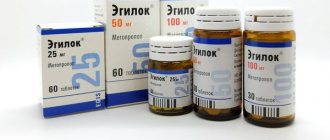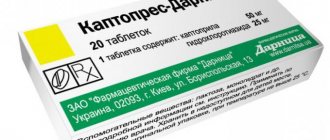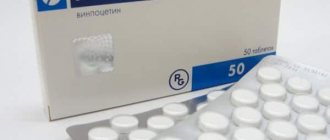Brief information about the drug
The blood pressure medicine Ramilong belongs to the pharmacological group of ACE inhibitor drugs that have a direct effect on the renin-angiotensin system.
Release form
The blood pressure drug Ramilong is presented on the pharmaceutical market in tablet form, which is most convenient for dosing and conducting a therapeutic course at home.
Composition and active substance
The main active component included in the drug is ramipril, presented in dosages of 2.5 mg, 5 mg or 10 mg.
The tablets also include excipients such as starch, microcrystalline cellulose, magnesium stearate, hypromellose, sodium starch glycolate.
Packaging of Ramilong tablets
pharmachologic effect
Ramilong is a drug that has a pronounced antihypertensive effect.
Manufacturer
The medicine Ramilong is produced by the Belarusian pharmaceutical company.
Terms and conditions of storage
The maximum permissible shelf life of tablets is 2 years. It is recommended to store the drug in a dark and dry place, inaccessible to children and pets. The optimal storage temperature should not exceed +25°C.
Terms of sale
You can purchase medication in pharmacy chains upon presentation of an appropriate medical prescription.
Price
The exact cost of the drug depends on the number of tablets in the package and the dose of the main active substance. The average price of Ramilong tablets varies from 4 to 14 Belarusian rubles.
Mechanism of action
A traveling pulsed magnetic field is significantly more effective in affecting the cells of the human body than alternating and constant fields. Thanks to this, the device:
- restores damaged cells and tissues;
- improves intracellular and intercellular metabolism;
- stimulates the restoration processes that occur in tissues.
A course consisting of 10-20 sessions helps relieve pain and improve well-being, and also promotes recovery.
Pharmacodynamics and pharmacokinetics
Ramilong blood pressure tablets have hypotensive and vasodilating properties. The drug has a beneficial effect on the condition and functions of the myocardium. It is important that Ramilong reduces pressure smoothly and gently, without increasing the heart rate and without negatively affecting the functioning of the renal apparatus.
The medicine is quickly absorbed by the body, once in the liver area it is transformed into ramiprilat.
The drug belongs to the group of ACE inhibitors
Ramilong lowers blood pressure after 1-2 hours from taking the tablets. The therapeutic effect lasts throughout the day, which avoids the need for frequent medication use.
At the same time, Ramilong is characterized by a cumulative effect. The best results are achieved with a course of tablets. After completing a full therapeutic course of 21 days, you can achieve stabilization of blood pressure for 2 years.
Interaction with other drugs
Shortens the effect of barbiturates, enhances the effect of narcotic analgesics.
Sources
- https://simptomov.com/preparat/kardiologiya/renin-angiotenzin/ramilong/
- https://www.neboleem.net/amilonosar.php
- https://www.webapteka.ru/drugbase/name18614.html
- https://upheart.org/lechenie/tabletki/amilonosar-effektivnoe-uluchshenie-mozgovogo-krovoobrashcheniya.html
- https://pro-acne.ru/sosudy-i-serdtse/amilonosar-instruktsiya-po-primeneniyu-otzyvy-tseny-2.html
- https://NeuroDoc.ru/lekarstva/amilonosar.html
- https://opohmele.ru/lechenie-alkogolizma/amilonosar.html
- https://gipertoniya-med.ru/lekarstva/ramilong.html
- https://VseDavlenie.ru/lekarstva/ingibitory/ramilong-pri-davlenii.html
- https://Cardio-help.ru/aptechka/ramilong-709
When use is contraindicated
Medical specialists prohibit patients with the following clinical contraindications from taking Ramilong if they have high blood pressure:
- Conn's syndrome;
- Hypotonic disease (consistently low blood pressure);
- Renal artery stenosis;
- Individual intolerance and hypersensitivity to substances contained in tablets;
- Pregnancy;
- Breastfeeding period;
- The presence of angioedema in the patient's medical history;
- Carrying out hemodialysis procedures;
- Treatment of nephropathy with non-steroidal anti-inflammatory drugs, angiotensin receptor antagonists, immunomodulators.
This drug is not used for the treatment of children and adolescents under the age of majority.
Ramilong is contraindicated for patients on hemodialysis
Instructions for use and dosage
Instructions for use of Ramilong recommend taking the tablets in the morning, without first crushing or chewing.
The recommended starting dosage of the drug for arterial hypertension is 2.5 mg per day. If there is no proper antihypertensive effect after 2 weeks of treatment, the daily dose of Ramilong can be increased to 5 mg or 10 mg.
With a sharp decrease in blood pressure, the dosage of the medication is reduced to 1.25 mg per day, and further treatment is carried out under strict medical supervision.
Adverse reactions
Treatment with Ramilong may cause the following side effects:
- A sharp decrease in blood pressure;
- Nausea and vomiting;
- Depressive states;
- Headache;
- Allergic rashes on the skin like urticaria;
- Stool disorders (constipation or diarrhea syndrome).
You must notify your doctor about any adverse reactions that occur during the therapeutic course! To solve the problem, you may need to reduce the daily dose of the drug or select a more suitable substitute!
Headache may be a side effect
Indications for use of the Almag 01 magnetic therapy device
What diseases does magnetic therapy help with? The list of such ailments is extremely wide. The list of indications for use of Almag 01 includes various diseases of the musculoskeletal system, neurological disorders, diseases of the cardiovascular system, etc.
Diseases of the musculoskeletal system for which the use of the device is indicated:
- osteochondrosis of the spine with reflex radicular syndrome, affecting the cervical, thoracic or lumbar regions;
- arthritis and arthrosis of various joints: glenohumeral periarthrosis, arthritis, epicondylitis, gout;
- deforming osteoarthritis;
- bursitis;
- myositis;
- paratenonitis
Damage to the musculoskeletal system and the consequences caused by them:
- bone fractures;
- wounds, soft tissue contusion, hematoma, post-traumatic edema;
- damage to ligaments and muscles;
- postoperative wounds;
- internal joint injuries;
- keloid scar;
- sluggishly healing purulent wounds, phlegmon, burns.
Neurological disorders:
- various diseases of the peripheral nervous system;
- neuritis: facial nerve, radial nerve, ulnar nerve, median nerve, sciatic nerve (sciatica), peroneal nerve;
- plexitis;
- neuralgia: trigeminal nerve, occipital nerve, intercostal neuralgia;
- spine and spinal cord injury;
- vascular diseases of the brain (with a combination of transient cerebrovascular accidents and chronic ischemic heart disease): cerebrospinal circulatory disorders, ischemic stroke.
Diseases of the cardiovascular system:
- hypertension stage I-II;
- renal hypertension;
- coronary heart disease with stable angina pectoris (in this case, the device must be used under the supervision of the attending physician);
- vegetative-vascular dystonia of the hypertensive type;
- obliterating atherosclerosis of the vessels of the lower extremities (obliterating endarteritis).
Dermatological diseases:
- itchy dermatoses;
- conditions after skin plastic surgery.
Chronic nonspecific lung diseases:
- chronic pneumonia;
- Chronical bronchitis;
- bronchial asthma.
Complications of diabetes:
- diabetic angiopathy;
- diabetic polyneuropathy.
Diseases of the gastrointestinal tract:
- biliary dyskinesia;
- pancreatitis in the subacute and chronic stages of the disease;
- chronic gastritis;
- peptic ulcer of the stomach and duodenum.
Diseases of the venous system of the upper and lower extremities:
- deep vein thrombosis of the leg;
- chronic thrombophlebitis in the stage of trophic disorders;
- varicose veins.
Diseases of the female genital organs:
- diseases caused by ovarian hypofunction;
- inflammatory diseases of the uterus and appendages during the subsidence of the acute process;
- condition after surgical delivery (caesarean section).
Drug overdose
The use of Ramilong tablets in excessively large dosages can cause the following alarming clinical symptoms:
- Violation of water and electrolyte balance in the patient’s body;
- Slow heart rate, severe bradycardia;
- Excessive and sharp decrease in blood pressure, up to the development of a hypotensive crisis;
- State of shock;
- Falling into a stupor.
In case of such a clinical picture, it is necessary to call an ambulance, and before the doctors arrive, provide the victim with first aid by performing a gastric lavage and giving a portion of sorbents. Further treatment of overdose with Ramilong is symptomatic and is prescribed by medical specialists on an individual basis.
Ramipril
Before starting treatment with Ramipril, it is necessary to eliminate hyponatremia and hypovolemia. In patients who have previously taken diuretics, it is necessary to discontinue them or at least reduce their dose 2-3 days before starting Ramipril (in this case, the condition of patients with chronic heart failure should be carefully monitored, due to the possibility of developing decompensation due to an increase in circulating blood volume).
After taking the first dose of the drug, as well as when increasing its dose and/or the dose of diuretics (especially loop diuretics), it is necessary to ensure careful medical monitoring of the patient for at least 8 hours so that appropriate measures can be taken in a timely manner in case of an excessive decrease in blood pressure.
If Ramipril is used for the first time or at a high dose in patients with increased RASS activity, their blood pressure should be carefully monitored. especially at the beginning of treatment, since these patients have an increased risk of excessive reduction in blood pressure (see section "With caution").
In case of malignant arterial hypertension and heart failure, especially in the acute stage of myocardial infarction, treatment with Ramipril should only
in a hospital setting.
In patients with chronic heart failure, taking the drug can lead to the development of a pronounced decrease in blood pressure, which in some cases is accompanied by oliguria or azotemia and rarely by the development of acute renal failure.
Caution should be exercised when treating elderly patients, as they may be particularly sensitive to ACE inhibitors; it is recommended to monitor renal function in the initial phase of treatment (see also section "Dosage and Administration").
In patients for whom a decrease in blood pressure may pose a certain risk (for example, in patients with atherosclerotic narrowing of the coronary or cerebral arteries), treatment should begin under strict medical supervision.
Caution should be exercised during physical activity and/or hot weather due to the risk of increased sweating and dehydration with the development of arterial hypotension due to a decrease in circulating blood volume and a decrease in sodium levels in the blood.
During treatment with Ramipril, it is not recommended to drink alcohol (ethanol).
A transient excessive decrease in blood pressure is not a contraindication for continuing treatment after stabilization of blood pressure. In case of repeated development of a pronounced decrease in blood pressure, the dose should be reduced or the drug discontinued.
The simultaneous use of Ramipril with drugs containing aliskiren or with ARA II, leading to double blockade of the RAAS, is not recommended due to the risk of an excessive decrease in blood pressure, the development of hyperkalemia and deterioration of renal function compared to monotherapy. The simultaneous use of Ramipril with drugs containing aliskiren in patients with diabetes mellitus and/or moderate to severe renal failure (GFR less than 60 ml/min/1.73 m2 body surface area) is contraindicated and is not recommended in other patients (see sections “Contraindications”, “Interaction with other drugs”).
Concomitant use with ARA II in patients with diabetic nephropathy is contraindicated (see sections “Contraindications”, “Interaction with other drugs”) and is not recommended in other patients.
Angioedema
Cases of angioedema of the face, extremities, lips, tongue, pharynx or larynx have been observed in patients treated with ACE inhibitors. If swelling occurs in the face (lips, eyelids) or tongue, or difficulty swallowing or breathing, the patient should immediately stop taking the drug. Angioedema localized in the area of the tongue, pharynx, or larynx (possible symptoms: difficulty swallowing or breathing) can be life-threatening and requires urgent measures to relieve it: subcutaneous administration of 0.3-0.5 mg or intravenous drip of 0.1 mg of epinephrine (adrenaline) (under the control of blood pressure, heart rate and ECG) followed by the use of glucocorticosteroids (iv, intramuscular, or orally); Intravenous administration of antihistamines (H1 and H2-histamine receptor antagonists) is also recommended, and in case of insufficiency of C1-esterase enzyme inactivators, the need to administer C1-esterase enzyme inhibitors in addition to epinephrine (adrenaline) can be considered. The patient should be hospitalized and monitored until symptoms are completely relieved, but not less than 24 hours.
In patients receiving ACE inhibitors. There have been cases of intestinal angioedema, which was manifested by abdominal pain with or without nausea and vomiting; in some cases, angioedema of the face was simultaneously observed. If a patient develops the symptoms described above during treatment with ACE inhibitors, the possibility of developing intestinal angioedema should be considered when making a differential diagnosis.
When used simultaneously with other drugs that can cause the development of angioedema, the risk of angioedema increases (see sections “Contraindications”, “Interaction with other drugs”).
Treatment aimed at desensitization to insect venom (bees, wasps) and concomitant use of ACE inhibitors can initiate anaphylactic and anaphylactoid reactions (for example, decreased blood pressure, shortness of breath, vomiting, allergic skin reactions), which can sometimes be life-threatening. During treatment with ACE inhibitors, hypersensitivity reactions to insect venom (for example, bees, wasps) develop faster and are more severe. If desensitization to insect venom is necessary, the ACE inhibitor should be temporarily replaced with an appropriate drug of a different class.
Life-threatening, rapidly developing anaphylactoid reactions, sometimes leading to shock, have been described with the use of ACE inhibitors during hemodialysis or plasma filtration using certain high-flux membranes (for example, polyacrylonitrile membranes) (see also membrane manufacturer's instructions). The combined use of ramipril and the use of this type of membrane, for example, for urgent hemodialysis or hemofiltration, should be avoided. In this case, it is preferable to use other types of membranes or avoid taking ACE inhibitors. Similar reactions were observed with low-density lipoprotein apheresis using dextran sulfate. Therefore, this method should not be used in patients receiving ACE inhibitors.
Liver dysfunction
In patients with impaired liver function, the response to treatment with Ramipril may be either enhanced or weakened. In addition, in patients with severe liver cirrhosis with edema and/or ascites, significant activation of the RAAS is possible, so special care should be taken when treating these patients (see also section "Dosage and Administration").
Surgical interventions
Before surgery (including dental surgery), it is necessary to warn the surgeon/anesthesiologist about the use of ACE inhibitors.
Close monitoring of newborns exposed in utero to ACE inhibitors is recommended. to detect arterial hypotension, oliguria and hyperkalemia. In oliguria, it is necessary to maintain blood pressure and renal perfusion by administering appropriate fluids and vasoconstrictors. These neonates are at risk for oliguria and neurological deficits, possibly due to decreased renal and cerebral blood flow due to the reduction in blood pressure caused by ACE inhibitors.
Cough
When using the drug Ramipril, a dry, unproductive, prolonged cough may occur, which disappears after stopping the use of ACE inhibitors, which must be taken into account in the differential diagnosis of cough during the use of an ACE inhibitor.
Ethnic characteristics
The drug Ramipril, like other ACE inhibitors, has a less pronounced antihypertensive effect in patients of the Negroid race compared to representatives of other races.
Ramipril should be prescribed with caution to patients of the Black race due to a higher risk of developing angioedema.
Patients after kidney transplantation
There is insufficient experience with the use of ramipril in patients who have recently undergone kidney transplantation.
Monitoring laboratory parameters before and during treatment with Ramipril
up to 1 time per month in the first 3-6 months of treatment.
Monitoring kidney function (determining serum creatinine concentrations)
When treating with ACE inhibitors, it is recommended to monitor renal function in the first weeks of treatment and subsequently. Particularly careful monitoring is required in patients with acute and chronic heart failure, impaired renal function, after kidney transplantation, patients with renovascular diseases, including patients with hemodynamically significant unilateral renal artery stenosis in the presence of two kidneys (in such patients, even a slight increase in serum creatinine concentration may be indicator of decreased kidney function).
Electrolyte concentration monitoring
Regular monitoring of serum potassium levels is recommended. Particularly careful monitoring of potassium levels in the blood serum is required for patients with impaired renal function, significant disturbances in water and electrolyte balance, and chronic heart failure.
Monitoring of hematological parameters (hemoglobin, number of leukocytes, erythrocytes, platelets, leukocyte formula)
It is recommended to monitor the general blood count to identify possible leukopenia. More regular monitoring is recommended at the beginning of treatment and in patients with impaired renal function, as well as in patients with connective tissue diseases or in patients simultaneously receiving other drugs that can change the peripheral blood picture (see section "Interaction with other drugs") . Monitoring the number of leukocytes is necessary for the early detection of leukopenia, which is especially important in patients with an increased risk of its development, as well as at the first signs of infection. If neutropenia is detected (the number of neutrophils is less than 2000/μl), discontinuation of treatment with ACE inhibitors is required.
If symptoms due to leukopenia appear (for example, fever, enlarged lymph nodes, tonsillitis), urgent monitoring of the peripheral blood picture is necessary. If signs of bleeding appear (tiny petechiae, red-brown rashes on the skin and mucous membranes), monitoring the number of platelets in the peripheral blood is also necessary.
Determination of the activity of “liver” enzymes, the concentration of bilirubin in the blood
If jaundice or a significant increase in the activity of liver enzymes appears, treatment with Ramipril should be stopped and medical supervision of the patient should be provided.
Pharmacological compatibility
The combination of tablets with non-steroidal anti-inflammatory drugs significantly reduces the hypotensive effect of Ramilong and the effectiveness of the therapeutic course.
Combination with diuretics and drugs containing potassium threatens the development of hyperkalemia. Also, potassium levels in the blood increase when ACE inhibitors are combined with Heparin.
With the simultaneous use of Ramilong with other antihypertensive medications, the risks of a decrease in blood pressure to critical levels and the development of a hypotensive crisis increase many times over. A similar effect is observed when combined with alcohol-containing drugs and alcoholic beverages. In addition, ethanol contributes to a more pronounced manifestation of side effects characteristic of Ramilong and increases the likelihood of developing a drug overdose.
It is strictly contraindicated to combine these blood pressure pills with hypoglycemic drugs.
During the therapeutic course, medical experts also recommend paying special attention to nutrition and limiting the percentage of salt in the daily diet as much as possible, and it is advisable to completely exclude it from the daily menu to increase the effectiveness of treatment.
Ramilong may be incompatible with other drugs
Specific features of use
During the period of taking the drug "Ramilong", it is necessary to constantly monitor the level of blood pressure, as well as certain blood parameters: the level of leukocytes and hemoglobin. In addition, electrolyte balance and indicators of adequate kidney function should be constantly monitored. This drug is prescribed with caution to people who are employed in jobs that require significant concentration and quick reactions. Ramilong is prescribed with extreme caution to patients with liver and/or kidney pathologies. After taking this drug for the first time, the patient should spend several hours under medical supervision.
It is not recommended to prescribe Ramilong simultaneously with potassium preparations and potassium-sparing diuretics, since in this situation the risk of developing hyperkalemia increases. It is also not recommended to additionally prescribe other drugs that reduce blood pressure due to the possible risk of severe hypotension (hypotension). Simultaneous use of drugs based on allopurinol, cytostatics and immunosuppressants increases the risk of developing leukopenia. The activity of Ramilong is reduced in case of simultaneous administration of non-steroidal anti-inflammatory drugs.
Analogues and substitutes
On the modern pharmaceutical market you can find and purchase the following substitutes, analogues of Ramilong:
- Ramilong Plus;
- Hartil;
- Ramimed;
- Ampril;
- Tritace.
It should be noted that with the exception of the drug Ramilong Plus, which is an absolute analogue of Ramilong, other medications have their own specific characteristics, contraindications, and side effects. For this reason, it is strictly not recommended to independently replace the blood pressure pills prescribed by the doctor with any of their analogues. If you need to select a substitute, you should seek help from a qualified specialist who will find the best option and explain how and in what dosage to take the medicine!
Ramilong for high blood pressure is an effective antihypertensive drug that not only normalizes tonometer readings, but also stabilizes them for a long time. In addition, the tablets have a beneficial effect on the heart and blood vessels, reducing the likelihood of developing, progressing, cardiac diseases. However, due to a number of restrictions on use, the drug can only be used as prescribed by a doctor, strictly observing the dosage and duration of the therapeutic course recommended by a specialist!
Advantages
Treatment with Almag has many advantages. The most important of them:
- ease of use - to conduct a session, you do not need to have special knowledge and skills;
- the ability to influence not only the skin, but also the internal organs of a person - this is achieved due to the fact that the magnetic field can penetrate 6-8 cm inside the human body;
- safety of the device - subject to the basic precautions indicated above, it can be used by elderly people, as well as people in a weakened state;
- good tolerance of the magnetic field by patients for whom other physiotherapeutic procedures are contraindicated;
- complete absence of any dependence or addiction, as well as side effects - you can calmly stop the procedures at any time;
- Almag treatment can be done at home, so you don’t have to periodically visit the treatment room, wait in line, or arrange an appointment time6;
- the ability to cover various problem areas in one course;
- long-term use - the average lifespan of the device is 5 years, but it can serve you longer.
The main advantage of the Almag 01 device is, of course, its high efficiency. It is confirmed by clinical studies conducted, in particular, at the Russian Scientific Center for Restorative Medicine and Balneology of the Ministry of Health of the Russian Federation and the Moscow City Clinical Hospital No. 1 named after N. I. Pirogov.










